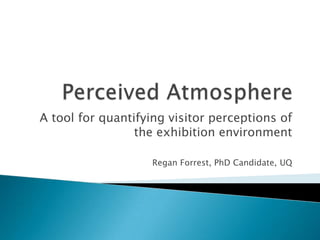Perceived atmosphere - a tool for quantifying visitor perceptions of the exhibition environment
- 1. A tool for quantifying visitor perceptions of the exhibition environment Regan Forrest, PhD Candidate, UQ
- 2. A Model for ŌĆ£Museum AtmosphericsŌĆØ Person-inEnvironment Perceived Atmosphere Visitor Responses ŌĆó Environmental Properties ŌĆó Affective ŌĆó Visitor (Consumer) Needs ŌĆó Cognitive ŌĆó Intended Atmosphere ŌĆó Behavioural Adapted from Kotler, 1974
- 3. ’üĮ ’üĮ ’üĮ Previous qualitative visitor research has suggested the exhibition environment is important (e.g. Packer, 2008; Roppola, 2012) Existing quantitative research has focused on relating a ŌĆ£goodŌĆØ environment to marketing-related outcomes (e.g. Bonn et al 2007) Can we do better than ŌĆ£goodŌĆØ?
- 4. ’üĮ ’üĮ ’üĮ ’üĮ Qualitative research exploring how visitors describe exhibition environments Pilot test terminology as semantic differentials and Likert scales (n=172) Refine word list to produce 30 semantic differentials (7-point scales) Use in visitor survey across four exhibition galleries at SA Museum (n=602)
- 5. Factor 1 Dramatic-Plain .719 Active-Passive .712 Vibrant-Dull .705 Ordinary-Striking -.597 Dynamic-Static .583 Colourful-Neutral .572 Energetic-Serene .515 Flat - 3-Dimensional 2 -.442 Factor 3 Linear-Winding .545 Symmetrical-Asymmetrical .538 Evenly Lit-Targeted Lighting .518 Dark-Light -.498 Old-New Varied-Repetitive .584 Traditional-Modern 4 .473 Warm-Cool Subdued-Bright Hard-Soft Cosy-Formal Ordered-Jumbled Small scale-Large scale Wide-Narrow .704 Spacious-Confined .672 Open-Enclosed -.462 .622 Structured-Unstructured .524 Flowing-Discontinuous .454 .509 Cluttered-Uncluttered .777 Organised-Random Simple-Complex Hidden-Obvious Principal Axis Factoring with Varimax rotation. Factor loadings below 0.4 are suppressed.
- 6. ’üĮ Vibrancy ŌŚ” Dramatic, Active, Vibrant, Striking, Dynamic, Colourful, Energetic, Three-Dimensional ’üĮ Spatiality ŌŚ” Wide, Spacious, Open, Uncluttered ’üĮ Modernity ŌŚ” Winding, Modern, Asymmetrical, Targeted Lighting, Dark, New ’üĮ Order ŌŚ” Ordered, Organised, Structured, Flowing
- 7. ’üĮ ’üĮ ’üĮ No gender difference besides a slightly higher spatiality rating from females Perceptions of vibrancy increase (a bit) with age No differences according to visiting group, history of visiting SA Museum or reason for visit, based on visitor ŌĆ£identityŌĆØ (Falk, 2009)
- 8. Individual Gallery Comparisons SABG PCG AACG-1 AACG-G -1 -0.5 0 Modernity 0.5 Vibrancy Order 1 1.5 Spatiality Perceived Atmosphere ŌĆō Gallery Comparisons (Zero = neutral score on 7-point Likert scale)
- 9. Gallery 5.10 4.21 4.42 Std. Deviation 1.09 1.05 .98 .83 100 99 96 97 5.23 5.15 4.35 4.37 Std. Deviation .90 1.03 .92 .82 165 164 163 161 Mean 5.09 5.27 3.95 3.18 Std. Deviation .96 .95 .99 .68 N 158 165 155 154 Mean 4.78 5.17 4.79 4.56 Std. Deviation 1.09 1.06 .94 .73 N 158 155 152 151 Mean 5.02 5.18 4.33 4.10 Std. Deviation 1.01 1.02 1.00 .95 N Total 4.97 N SABG Modernity Mean PCG Vibrancy N AACG-1 Order Mean AACG-G Spatiality 581 583 566 563 Summary Statistics ŌĆō Perceived Atmosphere NB: 7-point semantic differentials 4= neutral midpoint
- 10. ’üĮ ’üĮ ’üĮ ’üĮ Lowest Vibrancy Most Traditional Moderate-High Spatiality Moderate-High Order Pacific Cultures (PCG)
- 11. ’üĮ ’üĮ ’üĮ ’üĮ Moderate Vibrancy Moderate ŌĆō High Spatiality Moderate Modernity Moderate-High Order Aboriginal Cultures-1
- 12. ’üĮ ’üĮ ’üĮ ’üĮ Moderate Vibrancy Moderate Spatiality Moderate Modernity Moderate-High Order Aboriginal Cultures - G
- 13. ’üĮ ’üĮ ’üĮ ’üĮ Highest Vibrancy Lowest Spatiality Highest Modernity (N.S) Moderate-High Order SA Biodiversity (SABG)
- 14. Individual Gallery Comparisons SABG PCG AACG-1 AACG-G -1 -0.5 0 Modernity 0.5 Vibrancy Order 1 1.5 Spatiality Perceived Atmosphere ŌĆō Gallery Comparisons (Zero = neutral score on 7-point Likert scale)
- 16. ’üĮ ’üĮ ’üĮ ’üĮ Vibrancy is the strongest predictor of both affective and cognitive engagement (self report measures); Spatiality and Order to a lesser extent Spatiality is also a predictor of ŌĆ£relaxationŌĆØ Order is negative predictor of ŌĆ£disorientationŌĆØ No relationship between Modernity and any experience measures
- 17. ’üĮ ’üĮ ’üĮ ’üĮ Spatiality: an indicator of size but also space as an ŌĆ£affordanceŌĆØ (Gibson, 1977)? Order: no difference observed here. Could a wider range of exhibitions reveal differences? Modernity: a feature of this collection of galleries? Is lighting being confounded with other aspects of gallery design? Other sites? Gallery refurbishments? Temporary exhibitions?


















